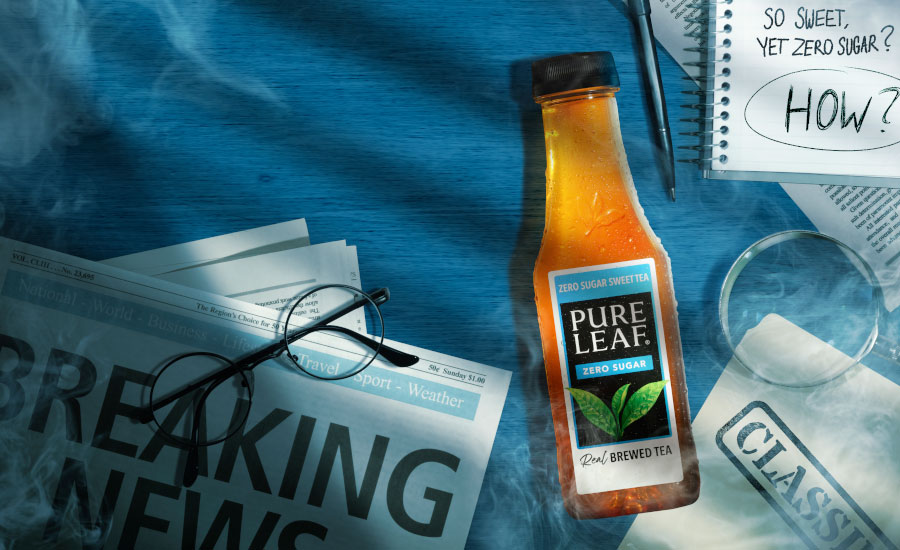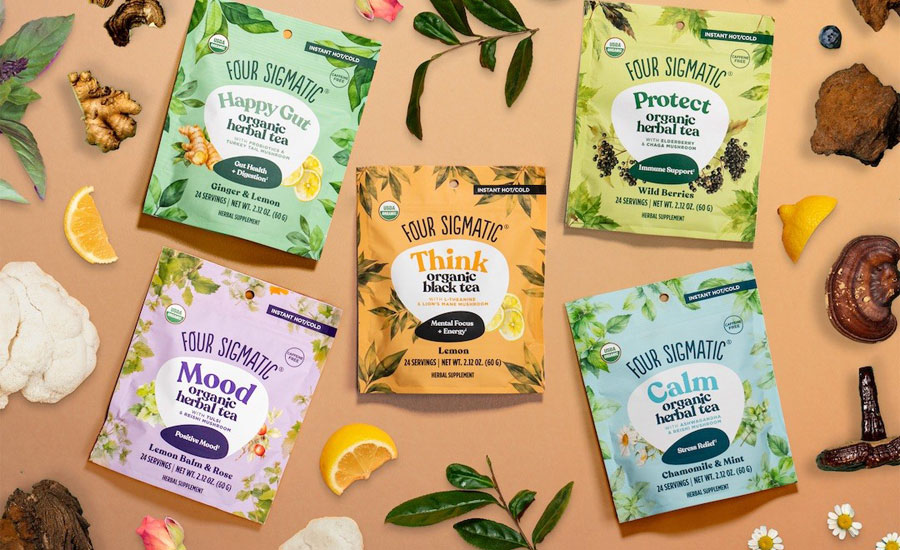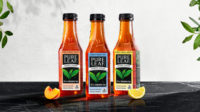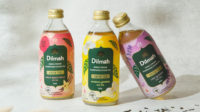Health attributes drive growth for tea, RTD tea category
Sugar reduction trends prompt innovations in RTD tea

Image courtesy of Arizona Beverage Co.
Known as one of the most influential women in the world, talk show host, TV producer, actress, author and media mogul Oprah Winfrey is quoted for saying, “Taking care of your body, no matter what your age, is an investment.”
Today, although inflation has impacted consumers’ purchasing decisions within the beverage market, when it comes to tea and RTD tea, experts note that growth in the category has been driven by consumers’ interest in well-being.
“The different varieties of teas aid consumers on a health and well-being journey,” says Sally Lyons Wyatt, global executive vice president and chief advisor for consumer packaged goods and foodservice at Circana, Chicago. “The many different functional benefits align with consumer needs for mental, physical and emotional well-being.
“Whether it’s for relaxation, energy, digestion, etc., tea is a ‘go to’ for many consumers,” she continues.
Noting that in both 2023 and year-to-date (YTD) 2024 the tea market grew in dollar sales but realized declines in unit sales, Lyons Wyatt points to products with no/low/less sugar in canned/bottled tea as “winning.”
Tea RTD and RFG (Total store view)
Source: Circana, Chicago. Total U.S. supermarkets, drug stores, mass merchandisers, gas and convenience stores, military commissaries, and select club ad dollar retail chains for the 52 weeks ending April 21,2024.“Refrigerated tea products with 100% natural claims, prebiotic/probiotic claims, artificial sweetener claims, low calorie claims and no sugar added claims are resonating with consumers,” she says. “Bags/loose tea products with claims like USDA/Certified Organic, Non-GMO Verified, unsweetened sugar claims are increasing in unit and dollar sales.”
Siân Edwards, director of strategy and insights at London-based Finlays, notes that, overall, the tea market has performed well in the past year.
“Despite some concerns about consumer spending impacting the category growth, hot tea and infusions have increased 8% and RTD teas have increased 6% [year-over-year] (YoY) in North America,” Edwards says, citing Euromonitor’s 2023 “Tea in US” report. “This is driven both by organic volume growth and price increases as the categories premiumize and consumers spend more on their tea products.”
Gary Hemphill, managing director of research at Beverage Marketing Corporation (BMC), Wintersville, Ohio, considers the category’s growth in 2023 to be muted.
“Overall tea category performance was soft in 2023. Inflation-driven higher prices made for a soft volume environment but better revenue performance,” he explains.
In its “Tea and RTD Tea, US - 2023” report, Chicago-based Mintel notes that despite ups and downs in the past three years — and volume declines — the category could be primed for a “renaissance” in a very competitive non-alcohol drink market.
“Growth in 2021-22 was deceiving: volume sales in the category struggled to stay positive until 2023 driven mainly by uncharacteristically strong performance in the instant mix segment,” the report states. “Keeping in step with shifts unfolding in the U.S. packaged coffee market, the draw of refreshment beverages in cold or iced form especially among younger adults are likely catalysts of segment performance, especially in the instant tea segment.
“Versatility is another salient draw for the broader category, offering consumers ways to make trendy, colorful and flavorful hot or cold beverages in single or multi-serve sizes that can shake-up not only occasions, but the industry,” it continues.
A range of options
As consumers remain focused on overall well-being, experts highlight how sugar reduction trends are impacting the RTD tea market.
“RTD tea is increasingly being positioned as a better-for-you alternative to traditional soft beverage categories such as carbonates, leaning on the positive consumer perceptions of tea as a natural, healthy ingredient,” Finlays’ Edwards says. “A key aspect of this is low/no/reduced sugar claims, which are now present on a third of RTD tea launches in the U.S. market. This is driving category growth and engagement from consumers seeking healthier alternatives.”
BMC’s Hemphill notes how tea has a fairly well-developed low and no sugar RTD segment.
“That’s because not only are there zero sugar products with diet sweeteners but there’s also a robust market for unsweetened tea — especially among tea purists,” he says.
Circana’s Lyons Wyatt echoes similar sentiments, noting that tea categories have a variety of options for consumers including those sweetened and unsweetened.

“Unsweetened is a smaller share but in some segments growing while in others sweetened is preferred,” she says. “It all comes down to consumer choice. When sugar content data is observed, there has been traction for unsweetened, real sugar, no sugar, cane sugar and Splenda.”
Finlays’ Edwards notes that, aside from sugar content impacting the U.S. tea market, treat and indulgence trends are driving consumer behavior as they seek affordable indulgences in a time of economic concern.
“This is manifested through category premiumization in the indulgent space (e.g. growth of bubble tea) and the health and well-being space (e.g. organic, single-origin premium teas),” he says. “Bubble tea in particular is such an exciting development, with fast-growing chains and tea beverages costing upwards of $7 demonstrating that even in the mature tea category, there are high-opportunity pockets of growth and innovation.”
Circana’s Lyons Wyatt points to consumers seeking variety as well as affordability in tea purchases.
“The quest for the entry price points and/or value-priced beverages will be a trend affecting all beverages,” she says. “This means retailers need an assortment of sizes from single serve to large (e.g., gallon) size offerings.
“Consumers are also seeking exciting and unique flavors in their beverages,” she continues. ”In teas, we do see some new flavor varieties, but the main shares are for the traditional tea flavors. Therefore, exciting and unique flavors should be used to refresh the shelf, aim for one extra product in the basket (increased buy rate) and/or gain new users.”
A market snapshot
As consumers keep finding new occasions and motivations for drinking tea, experts highlight which segments flourished, and which have struggled this past year.
“In 2023, all segments lost unit and volume sales, but gained in dollar sales spurred by price,” Circana’s Lyons Wyatt says. “Canned and bottled tea and refrigerated teas increased dollar sales the most. YTD 2024, bags/loose tea and refrigerated teas are realizing growth in both dollar and unit sales, as well as driving the most dollar sales gains.”
BMC’s Hemphill notes that loose tea experienced modest volume increase while all other segments declined in volume with the largest decline coming from the tea pod segment. “It was a different story for sales with all segments growing with the exception of pods,” he explains.
As far as which teas occupy the most share, Hemphill points to black tea as dominating the U.S. market.
“About 86% of the tea imported into the United States last year was black with the remainder green,” he says.
Circana’s Lyons Wyatt notes that black tea tops across the sub-categories, with exception of tea bags where herbal is the largest share. Meanwhile, top black tea dollar share is in refrigerated teas at 85%, she says.
Finlays’ Edwards adds that, in RTD, black tea accounted for over 50% of launches in 2023, and green tea 30% in the North American market.
“In the fruit and herbals category, this is slightly less with black tea and green tea accounting for a combined 40% of launches, as the presence of fruit and herbals is much higher,” he says.
A promising future
Although green and black tea continue to dominate the U.S. market, experts highlight the potential of other teas gaining share.
“There’s really strong potential for ‘other teas’ such as white tea and oolong,” Finlays’ Edwards says. “So far in 2024, 7.7% of RTD tea launches contain white tea — up from 4.2% in 2023 and 1% in 2022.
“Consumers are increasingly seeking new and elevated experiences, driving the interest in trying new products and types of tea,” he continues. “Botanicals, fruit and herbals are also demonstrating strong potential, particularly when blended with teas, linking to trends for health, indulgence and experimentation.”

Circana’s Lyons Wyatt notes that other tea types have gained share within segments across the United States.
“For example, in 2023 canned and bottled tea, matcha green tea, black and white, white and yerba mate gained unit and dollar sales,” she says. “In bag/loose tea, albeit small sales amounts, these types gained unit and dollar sales: organic green; black and herbal; red; Japanese green; red rooibos; matcha green; green with herb; and orange pekoe.”
Looking toward the future, Finlay’s Edwards anticipates that the U.S. tea market will continue to see gains in the next year.
“We’re looking forward to a really positive year for all tea categories, as consumer confidence returns, innovation drives excitement and brand owners look for ways to differentiate in an increasingly busy marketplace.” he says.
BMC’s Hemphill predicts that the market will witness moderate growth and slight improvement in the coming year.
“We expect modest volume improvement in the category as inflationary trends slow fairly dramatically,” he explains.
Circana’s Lyons Wyatt expects that market growth in unit sales will continue to be difficult, because of the blurring beverage universe.
“However, tea is inherently healthy which is positive,” she says. “It will take companies leveraging social and digital media to continue to educate consumers about teas’ benefits. Manufacturers and retailers should not assume the benefits are known by all consumers.”
Lyons Wyatt adds that personalized messages also should be leveraged. For example, “kids 12-17 years are one of the largest tea consumer groups,” she explains. “Target these consumers with messages about the benefits and work to get this existing customer base to buy more.”
Furthermore, she suggests showcasing innovative pairings to bring in new or younger generation consumers.
“By focusing on the basics plus the personalization mentioned above, the tea market could see continued strength in unit and dollar sales in both bags/loose tea and refrigerated teas, and potentially increase sales of the rest of the segments,” Lyons Wyatt concludes.
Looking for a reprint of this article?
From high-res PDFs to custom plaques, order your copy today!






